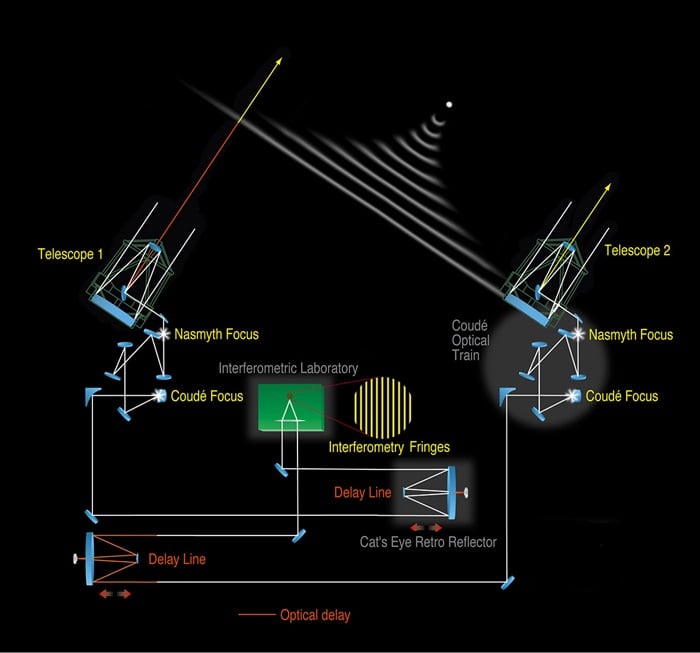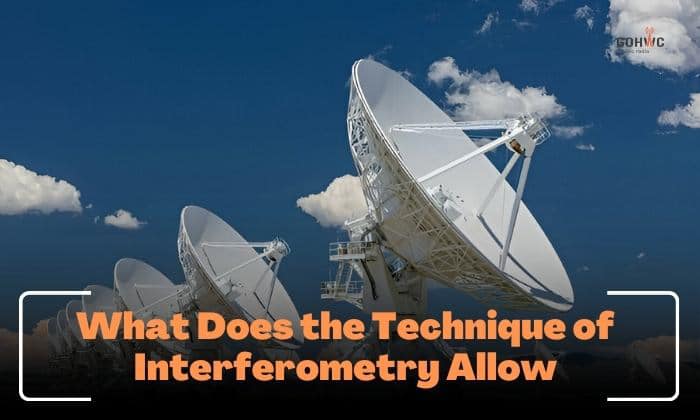Do not be intimidated by its name because once you learn what does the technique of interferometry allow, you will want to dig deeper.
Engineers and scientists are familiar with this technique — the use of interference to extract information (combining telescopes to boost their angular resolution or achieve better resolving power).
Experts employ interferometers to achieve such interference by adding two or more lightwaves. When the lightwaves interact, interference happens, and from which information is gained.
For instance, interferometers are used in telescopes to detect objects with more detail or measure the lightspeed from different directions. Though common in astronomy, interferometry is also helpful in engineering, telecommunications, and physics.
The Science Behind Interferometry

Think of this scenario: you’re in a dark alley riddled with obstructions. Luckily, you have not one but two flashlights, and you use them to spot obstructions as you walk along the passage. It need not be said that you need a light source to scope the area.
Consider interferometry, in which the lightwaves are employed to gather information, that is, the whereabouts of the obstructions. Hold tight as we get “sciencey” in the following paragraphs.
In the electromagnetic spectrum, humans can only see, as its name suggests, visible light (with wavelengths ranging from 380 to 700 nanometers). It need not be explained that optical telescopes work on this spectrum.
Radio telescopes, meanwhile, work with radio and microwaves between wavelengths of 10 meters and one milliliter.
When using optical telescopes, the goal is to achieve the highest angular resolution, or the angle between closely spaced out objects, so you can distinguish them. However, diffraction, or the bending of light, affects the image quality of telescopes.
Interferometry comes in to counter the challenges posed by the diffraction limit. A single interferometer is not enough to capture detailed information of distant objects, so using multiple devices is common among astronomers.
Combining the power of visual telescopes and interferometers gives users improved angular resolution – better images and information gathered. By connecting telescopes to interferometers, a stronger aperture is synthesized, so the view gets better.
Another way to visualize it is to imagine a room filled with big mirrors, with the light source distributed from different directions. The teeming light source – though glaring – is efficient in providing illumination.
As such, in optical telescope usage, more lights help us see distant objects – even the faintest ones.
A Quick Look at Radio Interferometers
Radio telescopes function through radio waves collected via antennas. Their interferometers are a network of multiple antennas connected to a single receiver, gathering data from the same source, say, light from a celestial object.
Without interferometers, antennas will not receive signals at the same time, so there’s a delay. This gap causes desynchronization even as the signal comes from a single source. In turn, radio images are not clear.
With interferometers, the combined reception of synchronized signals creates a stronger signal.
Radio telescopes rely on the signal strength received by interferometers, producing images similar in quality to those on large-aperture infrared telescopes. Consequently, an impressive angular resolution is achieved.
Conclusion
There are two kinds of telescopes: optical and radio. Both can use interferometers, with the former working with interference caused by waves of light, while the latter employs a network of antennas that heighten signals.
The goal is to collect detailed information; that’s why interferometers are commonly used by astronomers who want to scour outer space.
So what does the technique of interferometry allow? It lets humans explore the “infinity and beyond.”

Hi there! I am Howe, and I am the founder of G0HWC. I have been a radio enthusiast for as long as I can remember. I live and breathe radio, always taking the chance to blabber about it when customers seek my radio mechanic services.
Five years into working as a radio mechanic, I realized that most people struggle to fully understand the different complex aspects of owning and using a radio, though they understand the importance of having one.
And it dawned on me: I can put my blabbering to good use!
I started G0HWC to blabber all I want and help others who are not yet well-versed in radio language in doing so.

